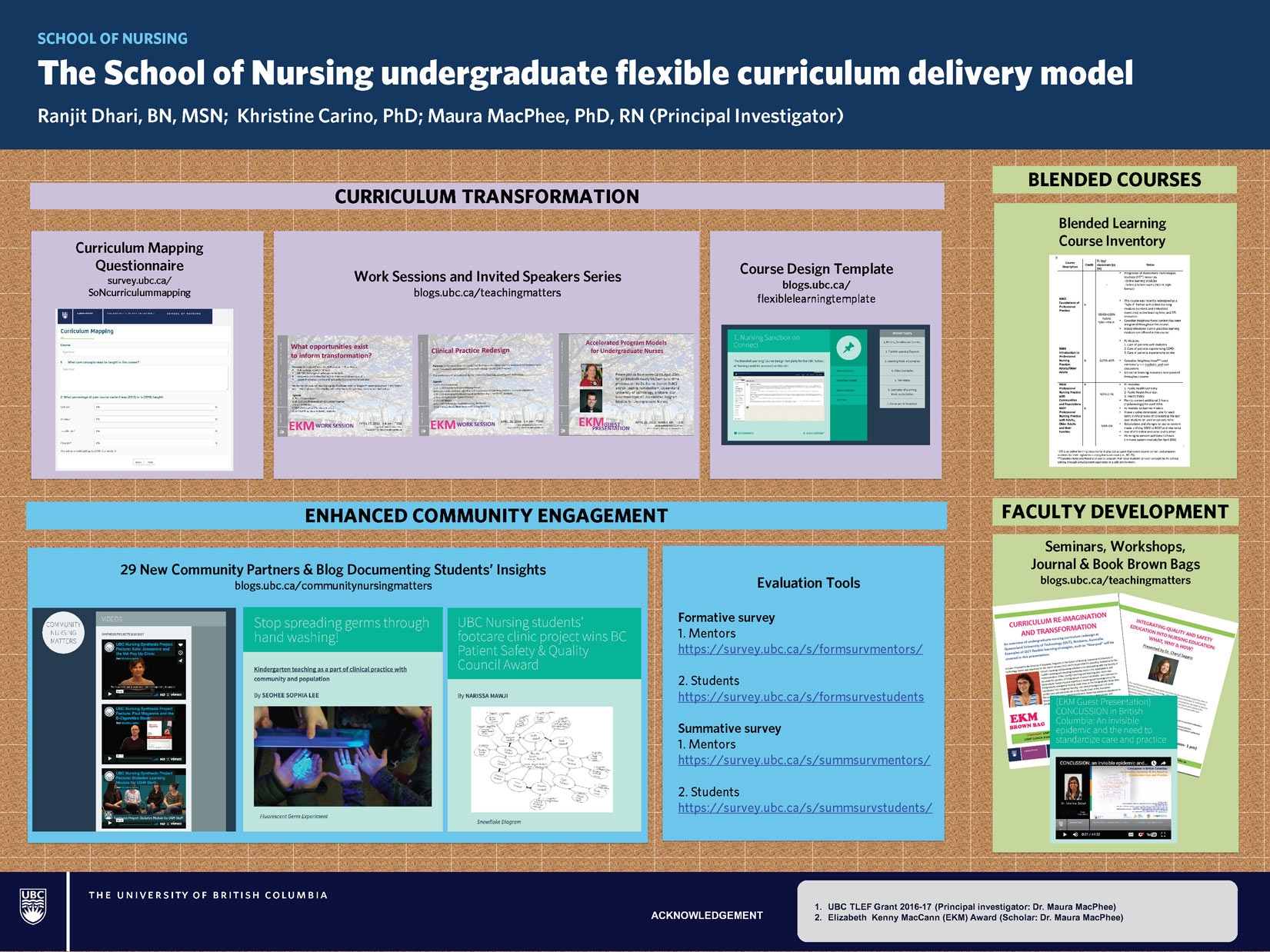| Title | The School of Nursing hybrid model of undergraduate curriculum delivery: a seamless approach for preparing our future nurses |
|---|---|
| Faculty/College/Unit | Applied Science |
| Status | Completed |
| Duration | 1 Year |
| Initiation | 04/01/2016 |
| Completion | 03/31/2017 |
| Project Summary | Our School of Nursing (SoN) is currently revising curriculum for our accelerated (20 month) undergraduate program. We plan to have new course descriptions and learning objectives in place for Senate review by September 2016. In tandem, we are developing a flexible curriculum delivery model to better meet student learning needs. The purpose of this TLEF project is to develop, implement and evaluate a seamless curriculum delivery model for our undergraduate program. Our proposed model will have four linked components: online learning, in-class active learning (e.g., case-based), skills lab simulations and community-based experiential learning. Health care is evolving rapidly due to shifting population needs, globalization and technology. Flexible curriculum delivery will enable us to keep pace with health care trends and better prepare future nurses Other project objectives are: faculty development (to ensure sustainability of the flexible delivery model post- funding); and enhanced community engagement through purposeful academic-health authority collaborations. |
| Funding Details | |
| Year 1: Project Year | Year 1 |
| Year 1: Funding Year | 2016/2017 |
| Year 1: Project Type | Large TLEF |
| Year 1: Principal Investigator | Maura MacPhee |
| Year 1: Funded Amount | 95,964 |
| Year 1: Team Members | Maura MacPhee, Associate Professor, Nursing, Faculty of Applied Science |
| Year 1: TLEF Showcase |  |
| Project Report | 2016-TLEF-LP-1_APSC_MacPhee-WEB.pdf |
| Project Outcomes | Products & achievements: A. CURRICULUM DELIVERY TRANSFORMATION: Standardized template to guide course delivery redesign; Curriculum delivery map that provides a visual schematic for how core content will be delivered per course and across the curriculum; Curriculum redesign work sessions (i.e. milestone: facilitate curriculum delivery redesign). B. ENHANCED EXPERIENTIAL LEARNING OPPORTUNITIES: 16 new community based clinical experiences; Documentation of community-based activities: faculty and student perspectives; Evaluation tools for community engagement activities; Co-developed simulation scenarios to offer to our nursing students and health authority nursing staff at health authority sites. C. CONCENTRATED BLENDED COURSES: Delivery redesign of 75% of our courses by the end of Year 1 funding; 10-25% blended options per course for all undergraduate courses (currently 23 courses); Create a blended learning inventory of actual/potential content per course and determine what options will be commercial versus customized. D. MEASUREMENT OF ENHANCEMENT OF STUDENT LEARNING AND EFFECTIVENESS: Competency assessment screening tools for each of our 4 undergraduate program levels and co-developed simulation scenarios to offer to our nursing students. E. ENHANCING INTERACTION AND COMMUNICATION: Monthly SoTL brownbag lunches and project workshops for academic and clinical faculty and our health authority partners authority nursing staff at health authorities sites; Faculty Development Plan. Intended outcomes/themes:
Evaluation approach: Formative and summative online surveys were deployed to evaluate Community Engagement activities. These surveys targeted students and community mentors, and data was analyzed qualitatively. Findings: Curriculum Delivery Transformation - No evaluation methods were conducted. However, recommendations from the results of Work Sessions (CTLT-facilitated curriculum review sessions and N334/N336 13-week rotation feasibility study) were considered by the SoN Curriculum Transformation Committee. The proposed revised curriculum was approved by the UBC Senate for implementation starting September 2017. Enhanced Experiential Learning Opportunities - Formative and summative evaluation outcomes informed the following recommendations: (1) Longer period of time for planning and implementation of community-based projects, (2) Ensure project expectations from both students and mentors coincide, (3) Provide internal (i.e. SoN) funding for materials needed for the projects, (4) Consider long-term projects that will be implemented with the participation of succeeding cohorts of nursing students. Dissemination:
Sustainability: Ongoing, self-sustaining project initiatives through faculty training and development are in place. By building faculty capacity, our faculty will be able to independently (or collaboratively) identify course content to offer online; maximize the use of existing resources (e.g., the SoN media room, the Applied Sciences LTRs, commercial resources); and produce and/or edit their own blended learning options for students. As new knowledge needs arise, faculty will be able to offer students more flexible learning options on an as needed basis. Also, an inclusive SoTL community for academic and clinical faculty and our health authority partners. We currently have faculty silos that diminish collaborative SoTL projects and research. Investment in academic-clinical faculty collaborations will provide better linkages and richer student learning opportunities across our curriculum. Our clinical faculty members are valuable liaisons with the health authorities: they nurture and support positive relationships between the SoN and the healthcare sector. Based on experience, these types of positive relationships enable our faculty to obtain quality student clinical placements that potentiate successful transition of students into employment positions after graduation. |